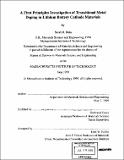A first principles investigation of transitional metal doping in lithium battery cathode materials
Author(s)
Buta, Sarah H. (Sarah Hume), 1972-
DownloadFull printable version (5.688Mb)
Other Contributors
Massachusetts Institute of Technology. Dept. of Materials Science and Engineering.
Advisor
Gerbrand Ceder.
Terms of use
Metadata
Show full item recordAbstract
The goal of this work is to understand the properties of mixed-metal intercalation oxides. Using first-principles methods, the effect of doping on the mixing, energetic, and voltage properties as well as the phase diagrams of lithium transition-metal oxides for lithium battery cathode materials was investigated. The effect of doping on the phase separation tendencies of layered transition-metal oxides was examined and it was found that for normal processing temperatures, Al is miscible in layered transition metal oxides (LiMO2) for five of the eight first-row transition metals studied. Temperature-composition phase diagrams for both Li(Al,Co)O2 and Li(Al,Cr)O2 were calculated. In these two systems, Al-doping is limited above 600°C by the formation of [gamma]-LiA1O2 and at very low temperatures owing to the existence of a miscibility gap. Reduced solubility is expected in the layered phase above 600°C for all oxides which have substantial solubility with LiA1O2 due to the formation of yLiAlO2. The effect of transition-metal doping on the average voltage properties in Mn-based spinets was calculated and the large increase in average voltage found experimentally was reproduced. A detailed analysis on the layered structure Li(Al,Co)O2 was performed, studying the energetics of different lithium sites and the effect of short-range clustering on the shape of the voltage curve. Though the average voltage is raised by Al substitution, the unexpected stability of sites with a few Al nearest neighbors leads to an initial decrease in voltage. For the Al-doped LiCoO2 system, a step in the voltage curve is found only for micro-segregated materials. When the Al and Co ions are randomly distributed in a solid solution, the voltage curve shows a continuous, gradual slope. The effect of oxygen defects in the Li(Al,Co)O2 system was investigated. A model for the effect of oxygen vacancies on the free energy of doped layered oxides was created by combining an ideal gas approximation and first-principles energy defect calculations. The results qualitatively confirm experimental studies on oxygen release in lithium battery materials.
Description
Thesis (S.M.)--Massachusetts Institute of Technology, Dept. of Materials Science and Engineering, 1999. Includes bibliographical references (p. 77-82).
Date issued
1999Department
Massachusetts Institute of Technology. Department of Materials Science and EngineeringPublisher
Massachusetts Institute of Technology
Keywords
Materials Science and Engineering.